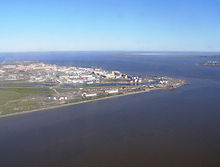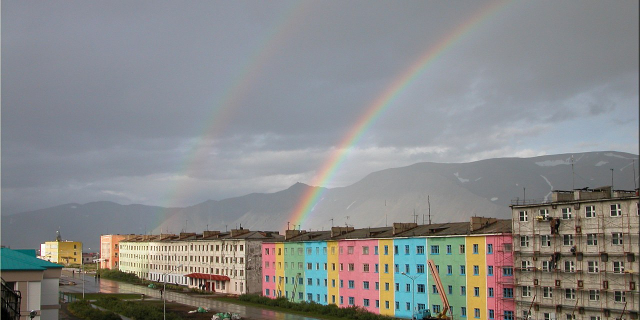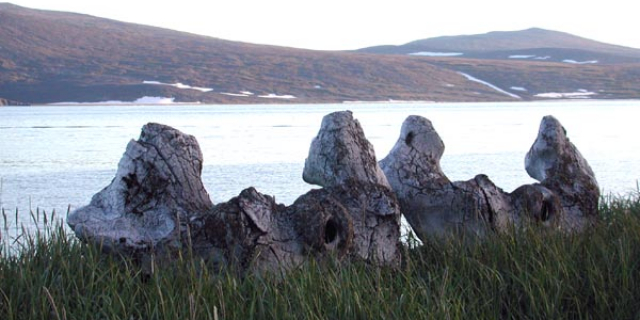Анадырь
( Anadyr (town) )
Anadyr (Russian: Ана́дырь, IPA: [ɐˈnadɨrʲ] ; Chukchi: Кагыргын, romanized: Kagyrgyn, IPA [kɑɣərˈɣən]; Southern Chukchi: Въэӈын, romanized: V"èňyn) is a port town and the administrative center of Chukotka Autonomous Okrug, Russia, located at the mouth of the Anadyr River at the tip of a peninsula that protrudes into Anadyrsky Liman. It was previously known as Novo-Mariinsk (until 1923). Anadyr is the easternmost town in Russia; more easterly settlements, such as Provideniya and Uelen, do not have town status....Read more
Anadyr (Russian: Ана́дырь, IPA: [ɐˈnadɨrʲ] ; Chukchi: Кагыргын, romanized: Kagyrgyn, IPA [kɑɣərˈɣən]; Southern Chukchi: Въэӈын, romanized: V"èňyn) is a port town and the administrative center of Chukotka Autonomous Okrug, Russia, located at the mouth of the Anadyr River at the tip of a peninsula that protrudes into Anadyrsky Liman. It was previously known as Novo-Mariinsk (until 1923). Anadyr is the easternmost town in Russia; more easterly settlements, such as Provideniya and Uelen, do not have town status.
Although the town itself has only been in existence for just over a century, the origins of the name Anadyr are much older. The name initially derives from the Yukaghir word "any-an" meaning "river". When Semyon Dezhnev met Yukaghir people in the area, the indigenous name was corrupted to form "Onandyr", later Anadyrsk, the name of the ostrog (fort) upstream of the present-day settlement, from which the current name is derived.[1] The ostrog was the only Russian settlement east of the Kolyma River on the Chukotka Peninsula for most of the 18th century,[2] though this original settlement was situated further up the Anadyr River, nearer to Markovo than the site of the current town.[2]
Pyotr Baranov (brother of Alexander Andreyevich Baranov) established a trading post near the present town site in the early 19th century and the Chukchi settled around it, forming the village of Vyon in 1830.[1]
The present settlement was founded in 1889 as Novo–Mariinsk[3] by L. F. Grinevetsky, who sailed into the Anadyrsky Liman on July 9, 1889.[1] The town's first building was completed twelve days later and as it was the name-day of Tsaritsa Maria Feodorovna the town was named Mariinsk. Since this was not the first time that a town had been named Mariinsk in Russia, the name was swiftly changed to Novo–Mariinsk.[1]
Early 20th centuryThe Kamchatka Revkom sent the first Bolsheviks—Mikhail Mandrikov and Avgust Berzin—to Anadyr to set up an underground organization to undermine and eventually overthrow the resident White Army forces stationed in the town.[4] These two, along with a small group of other Russian immigrants and a handful of Chuvans, established the First Revolutionary Committee of Chukotka.[4] Their presence initially went undetected, although it did arouse suspicion. However, just before they were about to be discovered by the resident White Army troops, they launched an attack against them on the night of December 16, 1919.[4] They intended to free the local indigenous people from their debts to the Russian incomers and dismantle the capitalist infrastructure that had been established in the town.[4] Their attempts at seizing the property of the merchant class in Anadyr were successful, but they were unable to seize control of the armory and ammunition supplies within the town.[4] The merchants used this opportunity to reassert themselves, and by January 30, 1920, they surrounded the Revkom's offices and attacked. One of the leaders, Vasily Titov, was killed and a number of others were wounded. Mikhail Mandrikov himself surrendered.[4] Although the survivors were initially imprisoned, the merchants decided to eliminate them permanently. Under the pretense of transferring them to another site, they led them out of the town and executed them out on the tundra.[4] The merchants' and White Army's success had been aided by the fact that a number of the Revkom members had been out the town visiting the village of Markovo. When these people returned, they were ambushed and all survivors eventually killed.[5]
 View of the Anadyr port
View of the Anadyr port Trinity Church
Trinity Church View of Anadyr from a helicopter
View of Anadyr from a helicopter Anadyr Child Creativity Palace, with the Lenin statue in front of the building
Anadyr Child Creativity Palace, with the Lenin statue in front of the buildingThe merchants set about reestablishing the status quo, all the while pretending to the Kamchatka Revkom that they themselves were socialists when inquiries came as to the whereabouts of their colleagues, going as far as to set up a fake Anadyr branch of the Russian Communist Party of Bolsheviks.[4] Unfortunately for the merchants in Anadyr, members of the first Revkom had already managed to establish branches in Markovo and Ust-Belaya, who were not convinced by the claims coming from Anadyr and, whilst establishing the Second Revolutionary Committee of Chukotka in Markovo[6] pressed the Kamchatka Revkom for assistance.[4] The Kamchatka Revkom responded by sending a party to investigate.[4] A number of those involved in the overthrow of the First Revolutionary Committee either ceased their political activity in the hope of blending into the background, or fled Chukotka for Alaska.[7] However, some merchants proclaimed an Independent Free State of Chukotka which existed for six months before the Bolsheviks returned and began to reorganize urban life.[1] Struggles continued for some time in the Russian Far East, and it took until early 1923 before communications were sent from Kamchatka by Red Army commanders indicating that all White Army forces in Chukotka had been eliminated.[8]
Monuments to those members of the First Revolutionary Committee were erected in Anadyr on 5 July 1921.[9] It was only in 1969 that an elderly man said he remembered where the bodies had been buried, having seen them being interred in a cemetery in Tavayvaam.[4] Following this tip, the remains were recovered and then paraded solemnly through Anadyr to the monuments, where they were buried with full honors.[10]
In 1923, Novo–Mariinsk was renamed Anadyr.[3]
WWII and the Cold WarDuring World War II, an airfield was built here for the Alaska-Siberian (ALSIB) air route used to ferry American Lend-Lease aircraft to the Eastern Front.[11]
During the 1960s, Anadyr was home to an R-12 Dvina (SS-4 Sandal) medium-range ballistic missile (MRBM) complex, which could target American military installations in Alaska.[12] The base was located 23 km (14 miles) northeast of Anadyr and was the USSR's only remote missile site.[12]
Anadyr was granted town status in 1965,[3] around which time it had a population of 5,600.[13]
The Hope Sled Dog Race was run between Anadyr and Nome, Alaska for more than a decade.[citation needed]
Modern historyIt is claimed that the town of Anadyr annexed the neighboring "ethnic village" of Tavayvaam in May 1994, and that this was done by then governor Alexander Nazarov with a view to saving money from the autonomous okrug's budget. If the village had indeed been absorbed into the town of Anadyr then there would have been no obligation for the autonomous okrug to allocate specific funds for the indigenous population there.[14]
In 2011, Paul Steinhardt led a group of scientists that landed in Anadyr en route to an expedition into the Koryak Mountains to search for naturally occurring quasicrystals.[15] Three quasicrystals have been found to date from the material gathered on that expedition, including icosahedrite, decagonite, a yet unnamed third natural quasicrystal, which (unlike icosahedrite and decagonite) is unlike anything ever previously synthesized in a laboratory. Steinhardt's team established that the natural quasicrystals were embedded in a meteorite that had hit Earth about 15,000 years ago.








Add new comment